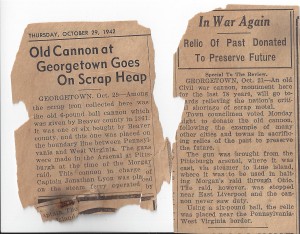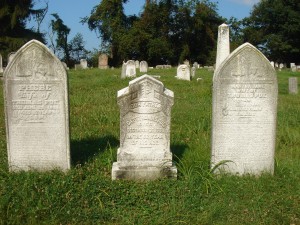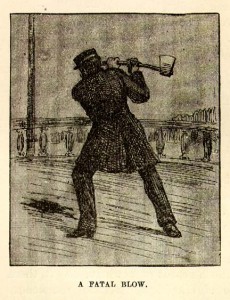This morn I was reading a newspaper article about “fracking” in PA. The article reminded me of a story attributed to Charley Poe. Charles Edgar Poe, the son of Capt Jacob Poe, was a gentleman and a great storyteller. His oil drilling tale was well told and well liked. From 1860-1885, oil and gas wells were drilled in every direction centered around Georgetown, PA.

Smith’s Ferry Oil Field ca 1865 (Anna L and John F Nash Collection)
This photo from the Western Advertiser dated 25 Jan 1972 illustrates the ferocity of the drilling efforts in Smith’s Ferry opposite Georgetown. There must be fifty derricks pictured on this spit of land. The wells of that time had little or no casing, and few if any were capped. To the best of my knowledge, there is no count or map of the wells drilled. Those holes are the problem.
There is also no public water system in Georgetown, PA. Drinking water is pumped from a private well on each property. The water from some wells nearby old drilling sites has an unpleasant “oily” taste after 150 years. Filters, softeners, and other water purification devices can not remove the taint.
I am curiously interested in the process of “fracking”. In Charley Poe’s day, oil drilling operators would “doctor” ailing wells. A charge of nitroglycerin was lowered into the well casing and discharged. If the results were good, a listless well would begin to produce oil or gas. This process was essentially “nitroglycerin fracturing” – the shale containing the oil or gas was fractured by the explosion releasing trapped petroleum.
Today the “fracking” boom is changing the landscape of southwestern PA, and Georgetown. The extraction technology has changed from nitroglycerin to a high pressure cocktail of chemicals too “top secret” to be disclosed by the drilling operators. And disclosure is not required by current PA DEP regulations. To date according to the following NPR website page, the total number of wells drilled in PA was 8,982 by 74 operators. There have been 3,025 citations issued for violating PA environmental regulations, primarily water contamination.
http://stateimpact.npr.org/pennsylvania/drilling/
Climate change is a theory that has been acknowledged and accepted by 97% of our environemental planet scientists. According to these scientists, carbon emissions from coal and oil fuels are a major cause of climate change. Why is more oil and gas production extracted by dubious means and long term side effects the solution to our economic problems. Fracking is the problem. And the solution?
Copyright © 2012 Francis W Nash
All Rights Reserved




